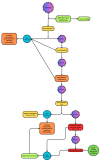Emergency Approach to Acute Seizures in Dogs and Cats
- PMID: 38922024
- PMCID: PMC11209469
- DOI: 10.3390/vetsci11060277
Emergency Approach to Acute Seizures in Dogs and Cats
Abstract
Seizures are a common presentation seen in small animal practices. Seizures require prompt management including initial interventions for triage, stabilization, and treatment with first-line anticonvulsant (AC) drugs like benzodiazepines. Concurrently, ruling out metabolic or extracranial causes with point-of-care diagnostics can help guide further diagnostics and treatments. Analysis of the history and a physical exam are also necessary to rule out common "look-alikes" that require specific diagnostic workup and treatments. Typically, causes of seizures can be grouped into intracranial and extracranial causes, with the latter being easier to diagnose with commonly available tests. This review presents a systematic approach to the diagnosis and treatment of single seizures, cluster seizures, and status epilepticus in dogs and cats.
Keywords: benzodiazepines; cats; cluster; dogs; levetiracetam; phenobarbital; seizure; status epilepticus; veterinary neurology.
Conflict of interest statement
The authors declare no conflicts of interest.
Figures



References
-
- Acierno M.J., Brown S., Coleman A.E., Jepson R.E., Papich M., Stepien R.L., Syme H.M. ACVIM consensus statement: Guidelines for the identification, evaluation, and management of systemic hypertension in dogs and cats. Vet. Intern. Medicne. 2018;32:1803–1822. doi: 10.1111/jvim.15331. - DOI - PMC - PubMed
Publication types
LinkOut - more resources
Full Text Sources
Miscellaneous

